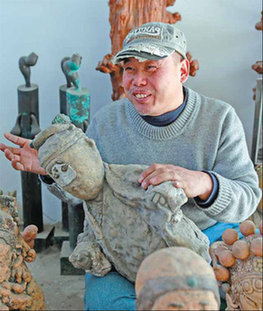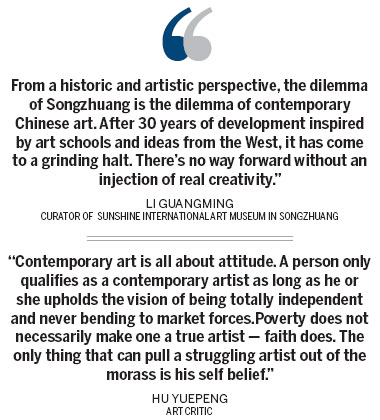Painting a grim picture in Songzhuang
Updated: 2012-11-22 08:53
By Zhao Xu (China Daily)
|
||||||||
A rural area in eastern Beijing has been home to an artistic community for two decades, but a downturn in the market and the rising price of land is dampening the fires of creativity, reports Zhao Xu.
Three years ago, Dou Jinjun would never have imagined that he would one day be reduced to hawking his artworks outside a bustling open-air antiques market in southern Beijing, hoping to attract a customer or two.
Thanks to the hordes of treasure hunters at the market, passing trade is good. From time to time, a passerby will cast a casual glance, before crouching down to make a closer examination of the rough and humble clay figures, whose barely open eyes and bridgeless noses somehow resemble those of their creator.
 |
|
Dou Jinjun surrounded by his clay sculptures in his Songzhuang studio. Photos by Feng Yongbin / China Daily |
The invitation may not always elicit a knowledgeable response in this more "pedestrian" part of the city, but as anyone who has dabbled in contemporary Chinese art will know, Songzhuang in the eastern suburbs of Beijing boasts China's, and most probably the world's, largest colony of artists who consider themselves socially conscious avant-gardists.
Over the past few years, the combined effects of a downturn in the lower-end art market and soaring local land prices have threatened to dampen a creativity that has been burning like wildfire since the first few "art outlaws" settled in the county almost two decades ago. It has also forced the overwhelming majority of the 5,000 artists-in-residence to the very edges of their already hardscrabble existences.
'Peripheral things'
"Galleries have long stopped coming for pictures," said painter An Kun, recalling the heyday of the area and contemporary Chinese art between 2004 and 2007. In those days, An would just sit and paint in his 110-square-meter studio, untroubled by "peripheral things" such as the payment of his annual 20,000 yuan ($3,200) rent. One of his regular patrons was a French gallery owner, who has since opened a space in Shanghai.
The good times didn't last and the art bubble burst amid the so-called financial tsunami of 2008. For those who endured the hardship and anonymity of Songzhuang's first decade, between 1994 and 2004, success arrived unexpectedly and ended abruptly.
However, according to An, who credits Songzhuang for his departure from classical Chinese painting and his adoption of a purely experimental style, one's feelings about the ongoing situation are in large part determined by the original motivation for living in the community. "If you want to breathe art in the air and find real soul mates, Songzhuang is the place to be," said the artist, who returns to his native Jiangsu province in Eastern China several times a year, but only feels ever more removed from his "car-driving, karaoke-singing bourgeoisie friends" back home.
Between 2005 and 2007, the number of artists living at Songzhuang rose from a couple of hundred to more than 2,500. Around 1,500 arrived in the year before the 2008 Beijing Olympic Games to cash in on what many believed would be a golden opportunity.
The envisioned opportunities failed to materialize and many of those who had arrived full of hope found themselves stranded, having spent all the money they had brought from home.
These days, wandering around the 116-sq-km rural area and knocking randomly on the doors of the little brick houses, one is more likely to discover a labyrinth of cramped rooms than an airy atelier. For many artists, a space of less than 10 sq m serves as living area, bedroom and studio combined, the crusted remains of meals sharing the tabletop with squeezed tubes of paint. Rent is usually around 300 yuan a month, but the tenants still struggle to pay that relatively modest amount and buy enough coal to keep Beijing's forbidding winter firmly on the doorstep.
 |

 Relief reaches isolated village
Relief reaches isolated village
 Rainfall poses new threats to quake-hit region
Rainfall poses new threats to quake-hit region
 Funerals begin for Boston bombing victims
Funerals begin for Boston bombing victims
 Quake takeaway from China's Air Force
Quake takeaway from China's Air Force
 Obama celebrates young inventors at science fair
Obama celebrates young inventors at science fair
 Earth Day marked around the world
Earth Day marked around the world
 Volunteer team helping students find sense of normalcy
Volunteer team helping students find sense of normalcy
 Ethnic groups quick to join rescue efforts
Ethnic groups quick to join rescue efforts
Most Viewed
Editor's Picks

|

|

|

|

|

|
Today's Top News
Health new priority for quake zone
Xi meets US top military officer
Japan's boats driven out of Diaoyu
China mulls online shopping legislation
Bird flu death toll rises to 22
Putin appoints new ambassador to China
Japanese ships blocked from Diaoyu Islands
Inspired by Guan, more Chinese pick up golf
US Weekly

|

|






